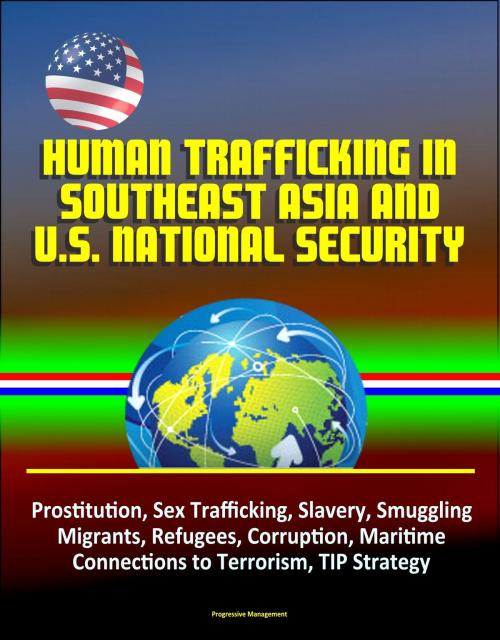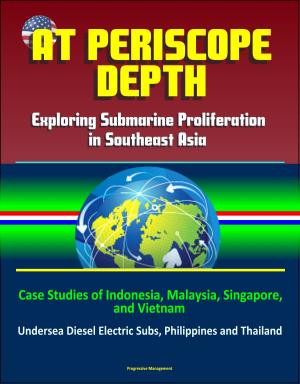Human Trafficking in Southeast Asia and U.S. National Security: Prostitution, Sex Trafficking, Slavery, Smuggling, Migrants, Refugees, Corruption, Maritime, Connections to Terrorism, TIP Strategy
Nonfiction, History, Military, Strategy, Social & Cultural Studies, Political Science| Author: | Progressive Management | ISBN: | 9781311530301 |
| Publisher: | Progressive Management | Publication: | March 27, 2016 |
| Imprint: | Smashwords Edition | Language: | English |
| Author: | Progressive Management |
| ISBN: | 9781311530301 |
| Publisher: | Progressive Management |
| Publication: | March 27, 2016 |
| Imprint: | Smashwords Edition |
| Language: | English |
Professionally converted for accurate flowing-text e-book format reproduction, this unique study asks the following question: How does trafficking in persons (TIP) affect U.S. national security interests and regional stability in Southeast Asia? The United States government finds human trafficking to be an important subject and is placing increasing focus on the issue. The Southeast Asian portion of the Western Pacific encompasses a substantial portion of global trafficking, much of which has a final destination in the United States.
To answer this question, this thesis examines how trafficking affects U.S. national security; the importance of combatting human trafficking in Southeast Asia to regional stability and to U.S. national security; levels of involvement the United States might seek to address the problem of human trafficking in Southeast Asia; and the possibility of an increase in maritime security efforts and interagency coordination in Southeast Asia to effectively combat human trafficking. U.S. national security is tied to regional stability through effects on economic interdependence and state partnerships. TIP threatens both, through its influence in transnational organized crime and the misuse of humans as an illegal resource. The thesis concludes by considering possible solutions to the problem that could be adopted by the United States military.
CHAPTER I * INTRODUCTION * A. MAJOR RESEARCH QUESTION * B. IMPORTANCE * C. POTENTIAL EXPLANATIONS AND HYPOTHESES * D. LITERATURE REVIEW * 1. What is Human Trafficking? * a. U.S. Official Definitions * b. NGO Definitions * c. IGO Definitions * 2. What Is the Cause of the Human Trafficking Problem? * 3. What Should Be Done? * 4. What Are the Literature Gaps? * E. METHODOLOGY * F. THESIS OVERVIEW AND BACKGROUND * CHAPTER II * HUMAN TRAFFICKING IN SOUTHEAST ASIA * A. ELEMENTS OF TIP IN SOUTHEAST ASIA * 1. Migration * 2. Refugees * 3. Remittances * 4. Unequal Development * 5. Weak Governance * 6. Corruption * 7. Maritime Trafficking * 8. Conclusion * B. ELEMENTS OF COUNTERING TIP IN SOUTHEAST ASIA * 1. IGOs and NGOs * a. UN * b. ASEAN * c. IOM * d. FTS * 2. STATE FACTORS * a. Institutional Barriers * b. TIP and TOC * C. CONCLUSION * CHAPTER III * TIP AND U.S. NATIONAL SECURITY INTERESTS IN SOUTHEAST ASIA * A. U.S. NATIONAL SECURITY STRATEGY * 1. Economic Stability * 2. Weak Governance * 3. Vulnerable Populations * 4. Regional Stability * B. U.S. NATIONAL SECURITY STRATEGY IN SOUTHEAST ASIA * 1. U.S. National Security Strategy in Southeast Asia * a. Trafficking Victims and Personally Identifiable Information * b. Connections to Terrorism and Funding Terrorism * 2. Maritime Security Concerns * C. TIP AND U.S. NATIONAL SECURITY STRATEGY IN SOUTHEAST ASIA * D. CONCLUSION * CHAPTER IV * U.S. EFFORTS TO COMBAT TIP * A. U.S. EFFORTS ON THE HOMEFRONT * 1. Policy Efforts * a. TIP Strategy * b. TVPA * c. TOC Strategy * 2. Border Patrol and DOD Coordination * 3. Prosecution Cases * B. CURRENT U.S. EFFORTS IN SOUTHEAST ASIA * 1. How the United States Works with IGOs and NGOs * 2. How the United States Works with State Governments * 3. U.S. Efforts in Coordination with Guam * 4. Evaluating U.S. Efforts to Combat TIP in Southeast Asia * C. GLOBAL U.S. EFFORTS * D. CONCLUSION * CHAPTER V * CONCLUSION * A. TRENDS IN TIP * 1. Global Trends * 2. U.S. Trends * 3. Southeast Asian Trends * B. TIP AND U.S. SECURITY INTERESTS IN SOUTHEAST ASIA * 1. Factors Contributing to TIP * a. Economic Effects * b. Government Instability * c. Vulnerable Populations * d. Regional Stability * C. RECOMMENDATIONS FOR THE UNITED STATES * 1. Potential Solutions * a. Policy Changes * b. Assets * c. Soft Power * d. Guam * D. SUMMARY * LIST OF REFERENCES
Professionally converted for accurate flowing-text e-book format reproduction, this unique study asks the following question: How does trafficking in persons (TIP) affect U.S. national security interests and regional stability in Southeast Asia? The United States government finds human trafficking to be an important subject and is placing increasing focus on the issue. The Southeast Asian portion of the Western Pacific encompasses a substantial portion of global trafficking, much of which has a final destination in the United States.
To answer this question, this thesis examines how trafficking affects U.S. national security; the importance of combatting human trafficking in Southeast Asia to regional stability and to U.S. national security; levels of involvement the United States might seek to address the problem of human trafficking in Southeast Asia; and the possibility of an increase in maritime security efforts and interagency coordination in Southeast Asia to effectively combat human trafficking. U.S. national security is tied to regional stability through effects on economic interdependence and state partnerships. TIP threatens both, through its influence in transnational organized crime and the misuse of humans as an illegal resource. The thesis concludes by considering possible solutions to the problem that could be adopted by the United States military.
CHAPTER I * INTRODUCTION * A. MAJOR RESEARCH QUESTION * B. IMPORTANCE * C. POTENTIAL EXPLANATIONS AND HYPOTHESES * D. LITERATURE REVIEW * 1. What is Human Trafficking? * a. U.S. Official Definitions * b. NGO Definitions * c. IGO Definitions * 2. What Is the Cause of the Human Trafficking Problem? * 3. What Should Be Done? * 4. What Are the Literature Gaps? * E. METHODOLOGY * F. THESIS OVERVIEW AND BACKGROUND * CHAPTER II * HUMAN TRAFFICKING IN SOUTHEAST ASIA * A. ELEMENTS OF TIP IN SOUTHEAST ASIA * 1. Migration * 2. Refugees * 3. Remittances * 4. Unequal Development * 5. Weak Governance * 6. Corruption * 7. Maritime Trafficking * 8. Conclusion * B. ELEMENTS OF COUNTERING TIP IN SOUTHEAST ASIA * 1. IGOs and NGOs * a. UN * b. ASEAN * c. IOM * d. FTS * 2. STATE FACTORS * a. Institutional Barriers * b. TIP and TOC * C. CONCLUSION * CHAPTER III * TIP AND U.S. NATIONAL SECURITY INTERESTS IN SOUTHEAST ASIA * A. U.S. NATIONAL SECURITY STRATEGY * 1. Economic Stability * 2. Weak Governance * 3. Vulnerable Populations * 4. Regional Stability * B. U.S. NATIONAL SECURITY STRATEGY IN SOUTHEAST ASIA * 1. U.S. National Security Strategy in Southeast Asia * a. Trafficking Victims and Personally Identifiable Information * b. Connections to Terrorism and Funding Terrorism * 2. Maritime Security Concerns * C. TIP AND U.S. NATIONAL SECURITY STRATEGY IN SOUTHEAST ASIA * D. CONCLUSION * CHAPTER IV * U.S. EFFORTS TO COMBAT TIP * A. U.S. EFFORTS ON THE HOMEFRONT * 1. Policy Efforts * a. TIP Strategy * b. TVPA * c. TOC Strategy * 2. Border Patrol and DOD Coordination * 3. Prosecution Cases * B. CURRENT U.S. EFFORTS IN SOUTHEAST ASIA * 1. How the United States Works with IGOs and NGOs * 2. How the United States Works with State Governments * 3. U.S. Efforts in Coordination with Guam * 4. Evaluating U.S. Efforts to Combat TIP in Southeast Asia * C. GLOBAL U.S. EFFORTS * D. CONCLUSION * CHAPTER V * CONCLUSION * A. TRENDS IN TIP * 1. Global Trends * 2. U.S. Trends * 3. Southeast Asian Trends * B. TIP AND U.S. SECURITY INTERESTS IN SOUTHEAST ASIA * 1. Factors Contributing to TIP * a. Economic Effects * b. Government Instability * c. Vulnerable Populations * d. Regional Stability * C. RECOMMENDATIONS FOR THE UNITED STATES * 1. Potential Solutions * a. Policy Changes * b. Assets * c. Soft Power * d. Guam * D. SUMMARY * LIST OF REFERENCES















